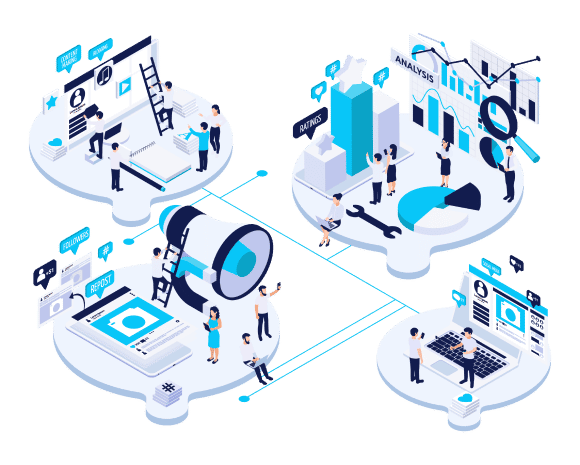Replatforming and Selecting eCommerce Tech Stack
Through the structured approach to the selection process and comparing over 50 solutions in the market.

Why do eCommerce
Brands Need Replatforming?
Brands on a legacy platform with too many add-ons may struggle with integration. Challenges could also be in centrally managing several brand sites. Some more challenges could be the unified commerce and omnichannel experience that may require brands to re-platform.
Too Many Add-ons
SMBs brands on Shopify and WooCommerce may use several add-ons for features such as return processing, recommendations, and reviews. These add-ons are likely to create data siloes and make integration challenging. When brands need to consolidate their add-on footprint, they might need to replatform.
Fragmented Omnichannel Experience
With add-ons and data siloes, the omnichannel experience may be patchy. And that could result in financial control issues because of fragmented loyalty and discounts. As well as pricing. The customer experience as the transactions move across channels may not be seamless. To provide the desired customer experience, replatforming may be necessary.
Duplicate Efforts Across Brand Sites
The smaller platforms don’t allow managing all brand sites in one database. As well as most certainly don’t have the publishing workflows that allow them to publish the same changes to multiple sites. As brands outgrow smaller systems, they need mature platforms that allow them to manage all brand sites centrally.
Exploring New Business Models
The new business models such as DTC, BOPIS, or ROPIS may require changing architecture. And if the current platform’s design may not support the desired architecture, replatforming may be necessary to support these business models.
Outgrowing Existing ECommerce Platform
The existing platforms might be limited in functionality. And may require substantial custom development. Or configurations that might be error-prone. Over time, brands mature with their eCommerce operations. And might require more sophisticated eCommerce platforms, driving the need for replatforming.
Rebranding
Considering rebranding, either because of the changes to the brand positioning. Or other strategic reasons. The brand may end up rewriting the whole platform to make the web assets consistent with the new brand and experience.
Want to learn more about why independent consultants have a higher success rate with eCommerce platform selection and replatforming?
Our Case Studies for
eCommerce Replatforming

ECommerce Supply Chain Transformation With ERP Selection
Download the eCommerce Supply Chain transformation case study and learn how LockNLube transformed its inventory and supply chain challenges by consolidating over 20 systems. As well as by creating business, process, information, and system architecture as they prepare for the next phase of their growth.

Omnichannel eCommerce Customer Experience Transformation
Download the omnichannel eCommerce customer experience case study and learn how fashion retailer AKIRA built a digital roadmap and managed stakeholder expectations to transform its processes and systems to explore newer business models such as buy-online-pickup-in-store and curbside pickup.

ERP Optimization and Integration Architecture Development
Download the ERP optimization and integration architecture development case study and learn how Work Sharp fixed their broken ERP implementation that caused customer service issues and improved Supply Chain planning.
Our Methodology
for eCommerce Replatforming
The process starts with the assessment to analyze whether replatforming would have higher ROI vs. augmenting the existing platform. Then the process moves on to performing deeper dive into requirements, architecture, and critical success factors that will drive the selection of the platform. The final steps might be releasing RFPs to different vendors, negotiating with them, and managing the entire program.

1 Assessment
This phase starts with the ROI analysis and business case development of the replatforming efforts. This phase goes through a series of discoveries and workshops to develop a better understanding of as-is processes and then proposes the process reengineering steps for the to-be processes. As well as capturing several options that could be further explored as the next step.
3Solution Analysis
This phase shortlists the potential solutions that meet the critical success factors. This phase also digs deeper into the architecture and all the defined interfaces that need to be built in the new platform. Finally, it proposes an initial plan for the implementation.
5Vendor Negotiations
This phase starts with capturing all the variables that might be cost drivers. Then for each of these variables, the appropriate financial model needs to be built that will be used to perform the financial analysis of various options. Then compare the financial model for each solution and invite vendors for negotiations.
2Requirements Analysis
This phase performs a deeper dive into the option identified in step 1 and captures the requirements from all the departments and functions such as search, product, pricing, and promotions. And then identifies the critical success factors that will drive the following phases.
4RFP Development and Vendor Reviews
This phase develops the RFP and invites vendors to respond to the RFP. The responses are then translated into an analytical model that helps stakeholders with decision-making. The phase then builds the demo script that can be sent to the vendors. The analytical model is further updated with the discoveries during the demos.
6Program and Change Management
This phase is about managing the entire program post-selection to ensure architecture, budget, and scope compliance. This phase also updates and executes the change management plan, including building a detailed training and communication plan.
Ready to learn how we can help With eCommerce Platform Selection and Replatforming?
Our Other
eCommerce Services
ElevatIQ eCommerce services include digital strategy roadmap, channel analysis, product profitability analysis, customer journey mapping, UX and conversion issues, eCommerce platform optimization, system integration, eCommerce platform selection, re-platforming, and contract negotiations.
Digital Commerce Business Model Transformation
This service helps eCommerce brands enable business models such as D2C, buy-online-pickup in-store, buy-online-return-in-store, or subscription-based business models.
Headless Commerce Strategy and Architecture
This service helps eCommerce brands with headless architecture enablement, whether you need a custom headless solution or integration with monolithic platforms such as SAP Hybris and Salesforce Commerce Cloud. Or utilizing a newer breed of headless platforms such as commercetools, Spryker, or VTEX.
E-commerce Solution Architecture
This service helps in setting the right foundation for your architecture, whether your architecture might contain just one platform or several, including PIM, DAM, DXP, and CMS. ElevatIQ can help define the architecture you need to enable customer experience.


